Manage Shipments
Locate Shipment list
- Barge Shipments are listed on Tasks > Shipment tab
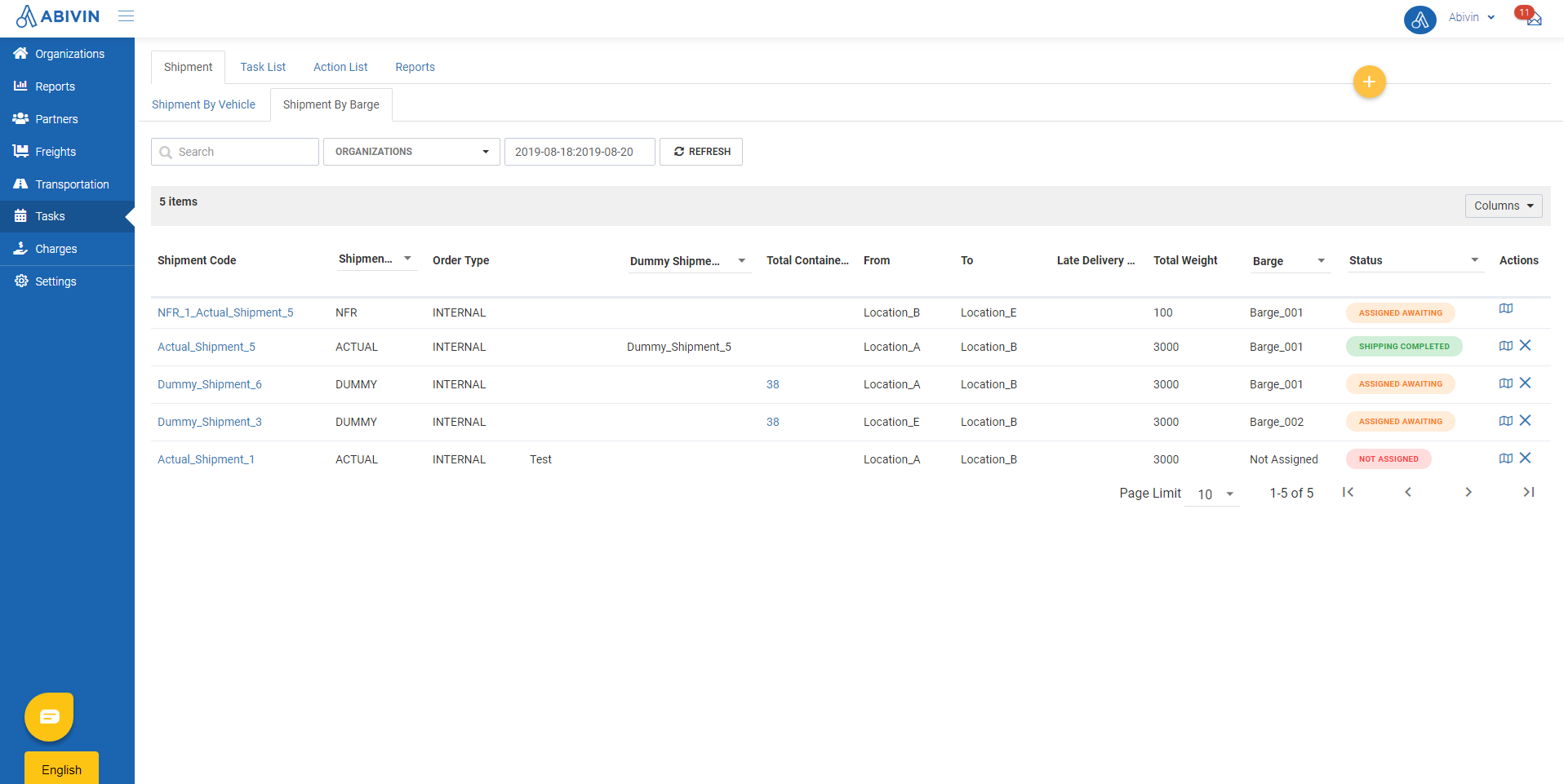
Shipment Information Fields
General Shipment information fields
- The general information of a Shipment is present on the tab Shipments (Web form) and the sheet Shipments (Excel template)
Information field | Description |
|---|---|
Shipment Code (Web form + Excel template) (Required) | Management code assigned to the Shipment being created |
Itinerary Code | Itinerary Code of the Shipment being created |
Leg Position | Numerical order of the itinerary leg of the Shipment being created |
Shipment Mode | Mode of transport used for the shipment being created |
Shipment Order Type | Order type of the shipment being created |
Shipment Type | Type of the shipment being created |
Transaction Type | Transaction Type of the shipment being created |
Vehicle | Vehicle Code of the barge that will perform the shipment being created |
Stuffing Date | The official due date to stuff goods to the containers of the shipment being created |
Cut-off Date | The latest possible date the containers of the shipment may be delivered to a terminal for loading to a ship |
Late Delivery Time | The date and time at which the shipment being created will be considered late to start |
Shipment Note | A specific note about the shipment being created |
Origin Customer Code | Code of the location where the shipment being created originally departs |
Destination Customer Code | Code of the location where the shipment being created ultimately arrives |
Shipment Stops information fields
- These information fields are present on the tab Stops (Web form) and the sheet Stops (Excel template)
Information field | Description |
|---|---|
Shipment Code (Web form + Excel template) (Required) | Management code assigned to the Shipment being created |
Shipment Stop Index | Numerical code of the shipment stop being created |
Location (Web form); Shipment Stop Location Code (Excel template) | Location code of the shipment stop being created |
Task Group (Web form); Task Group Code (Excel template) | This information fields is used only for Freight transport - Road model |
Shipment Stop Type | Type of the shipment stop being created |
Estimated Time Arrival | Estimated Time of Arrival at the shipment stop being created |
Planned Time Arrival | Planned Time of Arrival at the shipment stop being created |
Estimated Time Departure | Estimated Time of Departure from the shipment stop being created |
Planned Time Departure | Planned Time of Departure from the shipment stop being created |
Shipment Containers information fields
- These information fields are present on the tab Containers (Web form) and the sheet Containers (Excel template)
Information field | Description |
|---|---|
Shipment Code (Excel template) (Required) | Management code assigned to the Shipment being created |
Stop Index (Web form); Shipment Stop Index (Excel template) | Numerical code of the shipment stop |
Container Number | Numbers printed on the door of the container |
Seal Number | The numbers printed on the seal lock of the container |
Leg Position | |
Booking Number | Booking Number of the container included in the shipment being created |
Shipping Line | Code of the shipping line company that will transport the container |
Customer | Ultimate customer of the container |
Container Status | Most recent status of the container at the time the shipment is created |
Container Type | Type of the container |
Vessel | Code of the vessel that will transport the container |
Voyage ID | Code of the voyage that will transport the container |
Pick Location | Code of the location from where the container is picked up |
Drop Location | Code of the location to where the container will be dropped off |
IMO Class | IMO Class of the container |
Temperature | Temperature of the container |
Tare Weight | Weight of the container without loading any goods |
Gross Weight | Maximum goods weight that the container can carry |
VGM | Short for Verified Gross Mass - The verified weight of the cargo plus the tare weight of the container |
Note | A short note about the container |
Create shipments
- There are two methods to create shipment: Using Web form and using Excel template
Create shipments using Web form
- Please refer to the CRUD functions article to know the general steps about creating single object using Web form
- Below is the input instruction for each information field on Web form
1. Tab Shipments
- First, you have to click on Shipment Mode field, select the value BARGE from the drop down menu
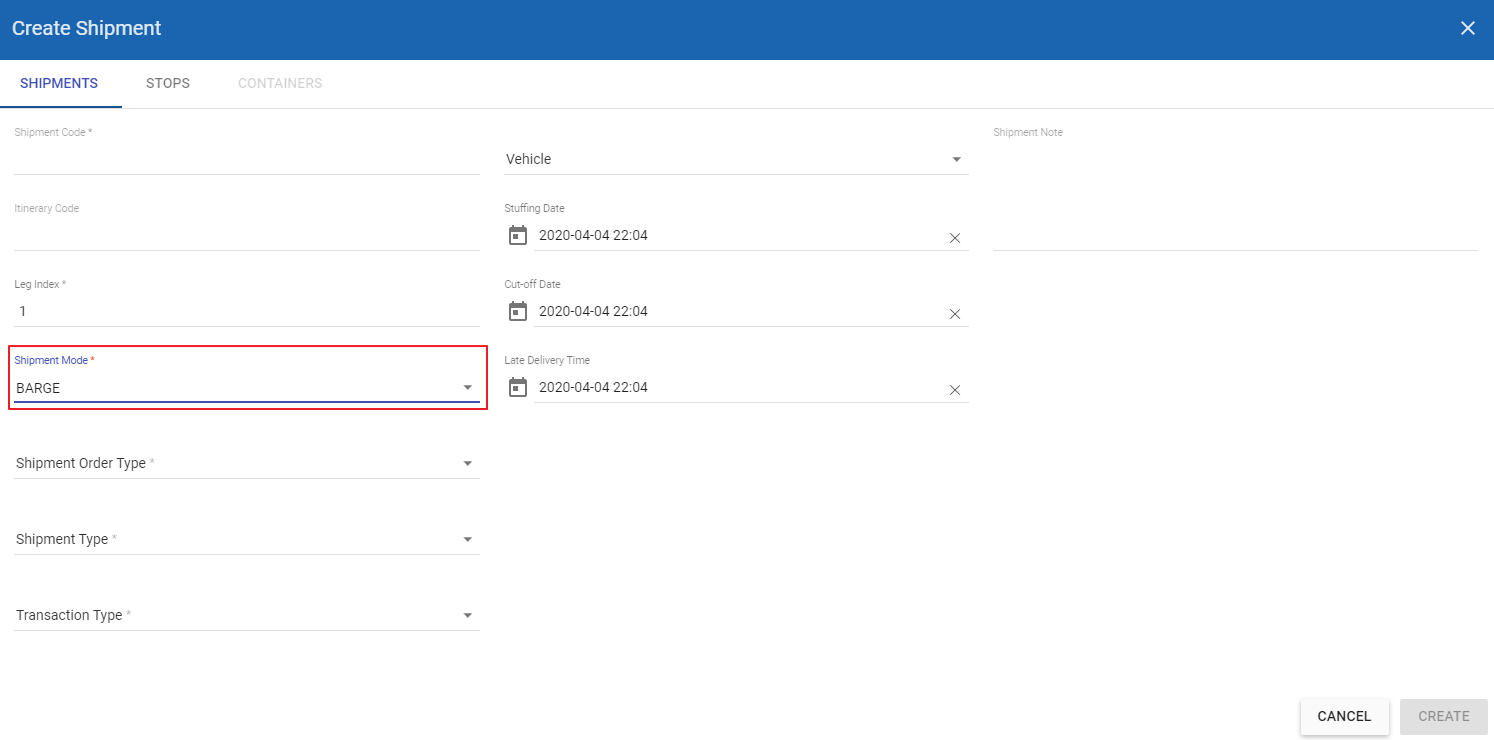
- Then, input in other information fields
- Below are some notes when creating/assign Shipments
Barge assignment rules
- When the dispatchers try to assign a Shipment to a particular barge, the system will validate some rules
- The general rules are:
- 1 - With nonempty Shipments (Dummy, Internal and External Actual Shipments), at any particular time point, the barge can only be assigned a maximum of one ongoing Shipment (Shipment currently being performed) and one pending Shipment (Shipment waiting to be performed)
- 2 - With empty Shipments (Non-freight Related, or NFR Shipments), you can assign a NFR Shipment to a barge right after its corresponding Actual Shipment has been assigned to that barge
Dummy Shipments
- If the barge is currently not performing any Shipment, then you can assign a new Dummy Shipment to that barge
- You can not assign a new Dummy Shipment to a barge if that barge is still performing another Dummy Shipment. Only after the preceding Dummy Shipment has been completed the new one can be assigned
- You can not assign a new Dummy Shipment to a barge if that barge has already been assigned an External Actual Shipment, and the barge captain has yet to submit tasks of that External Actual Shipment on Mobile app
Internal Actual Shipments
- You can assign a new Internal Actual Shipment to a barge even if the barge is still performing, hasn't yet completed an External Actual Shipment
External Actual Shipments
- You can not assign a new External Actual Shipment to a barge if that barge has a completed Dummy Shipment that has not been linked with an Internal Actual Shipment
- You can not assign a new External Actual Shipment to a barge if that barge has already been assigned an External Actual Shipment, and the barge captain has yet to submit tasks of the preceding External Actual Shipment on Mobile app
Non-freight Related (NFR) Shipments
- At any particular time point, a barge can be concurrently assigned one Internal NFR Shipment and one Eternal NFR Shipment
2. Tab Stops
- After you have input all necessary information on tab Shipments, navigate to tab Stops
- On this tab, you have to add the Shipment Stops to the Shipment being created. Start by clicking on Location field, input either the name or code of the appropriate location into the search bar, then select from the drop down menu
- The names and codes of the locations can be found under Customer Code and Customer Name columns in Partners > Customer List tab
- Next, click on Stop Type field, select the appropriate stop type from the drop down menu
- Then, click on Add Stop button to add the stop to the shipment
- The stop will appear in the stop list below
- Repeat these steps for other stops

- In the stop list, you have to specify the Estimated Time Arrival; Planned Time Arrival; Estimated Time Departure; Planned Time Departure for each stop. To do that, click on the calendar icon of each corresponding information field, then select the appropriate date/hour/minute/second from the drop down calendars

- If you accidentally add the wrong stop, you can remove it by clicking on trash bin icon under Action column

3. Tab Containers
- After you have added all stops of the shipment in tab Stops, let's navigate to tab Containers to add containers to the shipment
- First, click on Stop Index field. The drop down menu will list all available Pick Stops that you have added earlier, along with their numerical order. Select the appropriate Pick Stop from the list
- Next, input container number into Container Number field. Then, click on Add Container button. Repeat these steps for other containers
- The containers will appear in the container list below. You then need to input information for each container
Container number format
- You can input freely into Container Number field. However, only containers that have their numbers written correctly in ISO standard (for example CSQU3054383) will show up on Mobile app
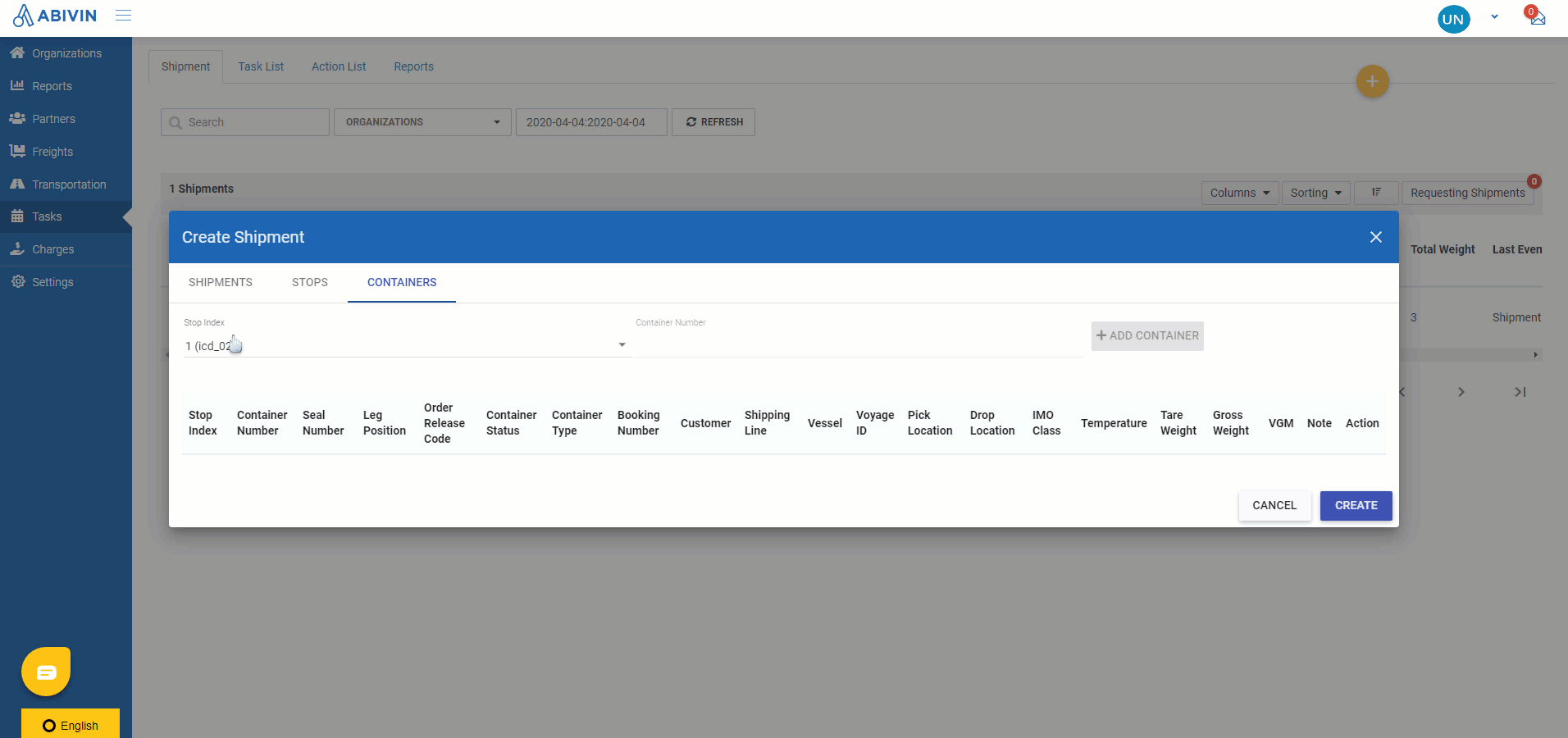
Adding container to Shipment
- If you accidentally add the wrong container, you can remove it by clicking on trash bin icon under Action column

- Finally, click on the button Create to finish creating the shipment

Create shipments using Excel template
- Please refer to the CRUD functions article to know the general steps about creating single object using web form
- Below is the input instruction for each information field in the Excel template
Sheet Shipments
2.1. Shipment Mode
- First, you have to input the following value into Shipment Mode cell (Note: All letters must be uppercase): BARGE
2.2. Shipment Type
- Input only one appropriate value from the following three values into this cell (Note: All letters must be uppercase): ACTUAL; DUMMY; NFR
2.3. Transaction Type
- Input only one appropriate value from the following seven values in the table below into this cell
Value on Web form | Corresponding value in Excel template |
|---|---|
IMPORT | I |
EXPORT | E |
DOMESTIC | D |
EXPORT - IMPORT | E,I |
DOMESTIC - IMPORT | D,I |
DOMESTIC - EXPORT | D,E |
DOMESTIC - EXPORT - IMPORT | D,E,I |
2.4. Shipment Order Type
- If the shipment order type of the shipment is internal, input the following value into this cell (Note: All letters must be uppercase): INTERNAL
- If the shipment order type of the shipment is external, input the following value into this cell (Note: All letters must be uppercase): EXTERNAL
2.5. Vehicle
- Copy the Vehicle Code of the appropriate barge on Web app, then paste into this cell
- The Vehicle Code can be found under Vehicle Code column in Transportation > Vehicle List tab
2.6. Origin Customer Code; Destination Customer Code
- Copy the Customer Codes of the appropriate customers on Web app, then paste into these cells
- The Customer Codes can be found under Customer Code column in Partners > Customer List tab

2.7. Itinerary Code
- Input the corresponding itinerary code of the shipment into this cell

2.8. Leg Index
- Input the corresponding Leg index of the shipment into this cell

2.9. Shipment Mode
- Always input the following value into this cell: BARGE
2.10. Shipment Type
- Input the following value into this cell if the shipment being created is a Dummy shipment: DUMMY
- Input the following value into this cell if the shipment being created is an Actual shipment: ACTUAL
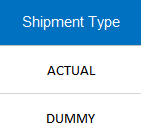
2.11. Transaction Type
- Input only one of the following six values from the below table into this cell
Value on Web form | Corresponding value in Excel template |
|---|---|
IMPORT | I |
EXPORT | E |
DOMESTIC | D |
EXPORT - IMPORT | E,I |
DOMESTIC - IMPORT | D,I |
DOMESTIC - EXPORT | D,E |
DOMESTIC - EXPORT - IMPORT | D,E,I |
2.12. Vehicle
- Copy the Vehicle Code of the barge on Web app, then paste into this cell
- The Vehicle Code can be found under Vehicle Code column in Transportation > Vehicle List tab
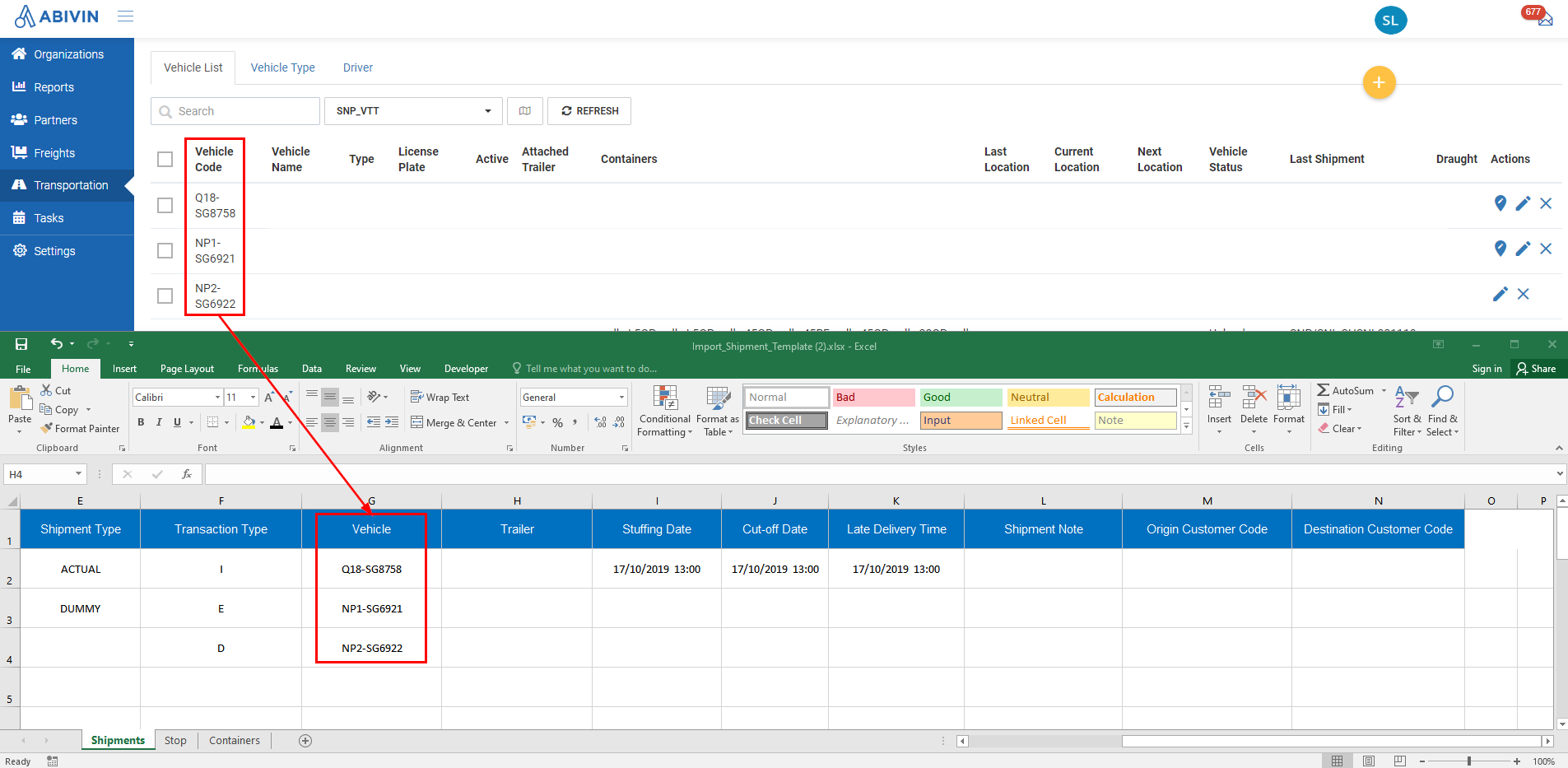
2.13. Trailer
- This information field is only used for Freight transport - Road model. Just leave this cell blank
2.14. Stuffing Date; Cut-off Date; Late Delivery Time
- These dates must be input in the following format: dd/mm/yyyy hh:mm
- For example: 20/11/2019 12:30
2.15. Shipment Note
- Format: Free-form
Sheet Stop
2.16. Shipment Code
- Same as instructed above
2.17. Shipment Stop Index
- Input the corresponding numerical order of the shipment stop into this cell
- For example: 1; 2; 3 and so on
2.18. Shipment Stop Location Code
- Copy the Customer Codes of the corresponding locations on Web app, then paste into these cells
- The Customer Codes can be found under Customer Code column in Partners > Customer List tab
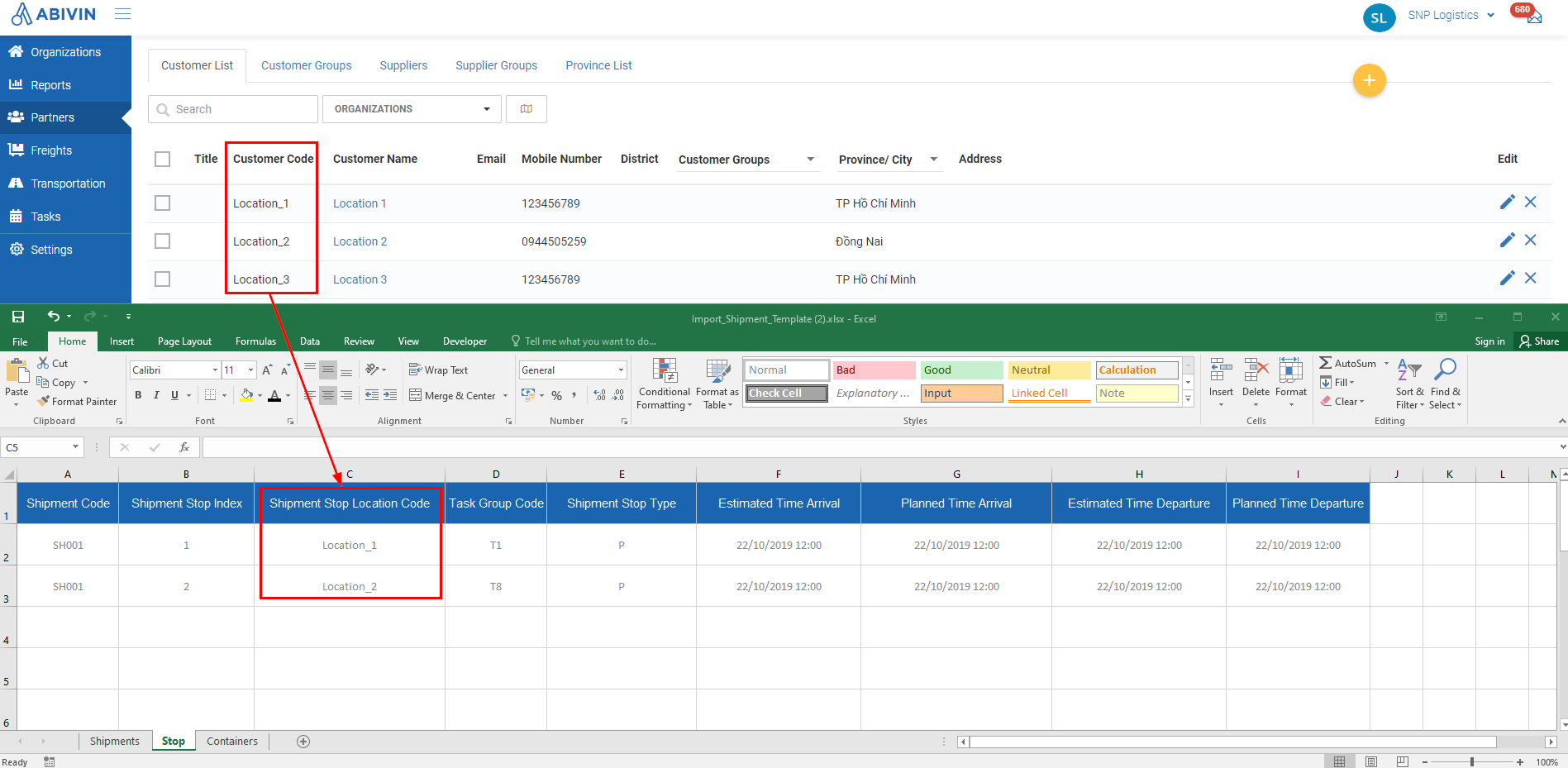
2.19. Task Group Code
- This information field is only used for Freight transport - Road model. Just leave this cell blank
2.20. Shipment Stop Type
- If the stop is a Pick stop, input the following value into this cell: P
- If the stop is a Drop stop, input the following value into this cell: D
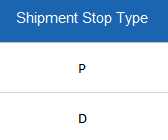
2.21. Estimated Time Arrival; Planned Time Arrival; Estimated Time Departure; Planned Time Departure
- These dates must be input in the following format: dd/mm/yyyy hh:mm
- For example: 18/11/2019 08:30

Sheet Container
2.22. Shipment Code
- Same as instructed above
2.23. Shipment Stop Index
- Same as instructed above
2.24. Container Number
- Input the numbers of the container into this cell
- For example: TKRU426221
2.25. Booking Number
- Input the Booking Number that comes with the container into this cell
- For example: 403772CHLTB
2.26. Seal Number
- Input the numbers of the seal lock of the container into this cell
- For example: ES2633201
2.27. Shipping Line
- Input the code of the shipping line into this cell
- For example: OCL_LN
2.28. Customer; Pick Location; Drop Location
- Copy the Customer Codes of the corresponding locations on Web app, then paste into these cells
- The Customer Codes can be found under Customer Code column in Partners > Customer List tab
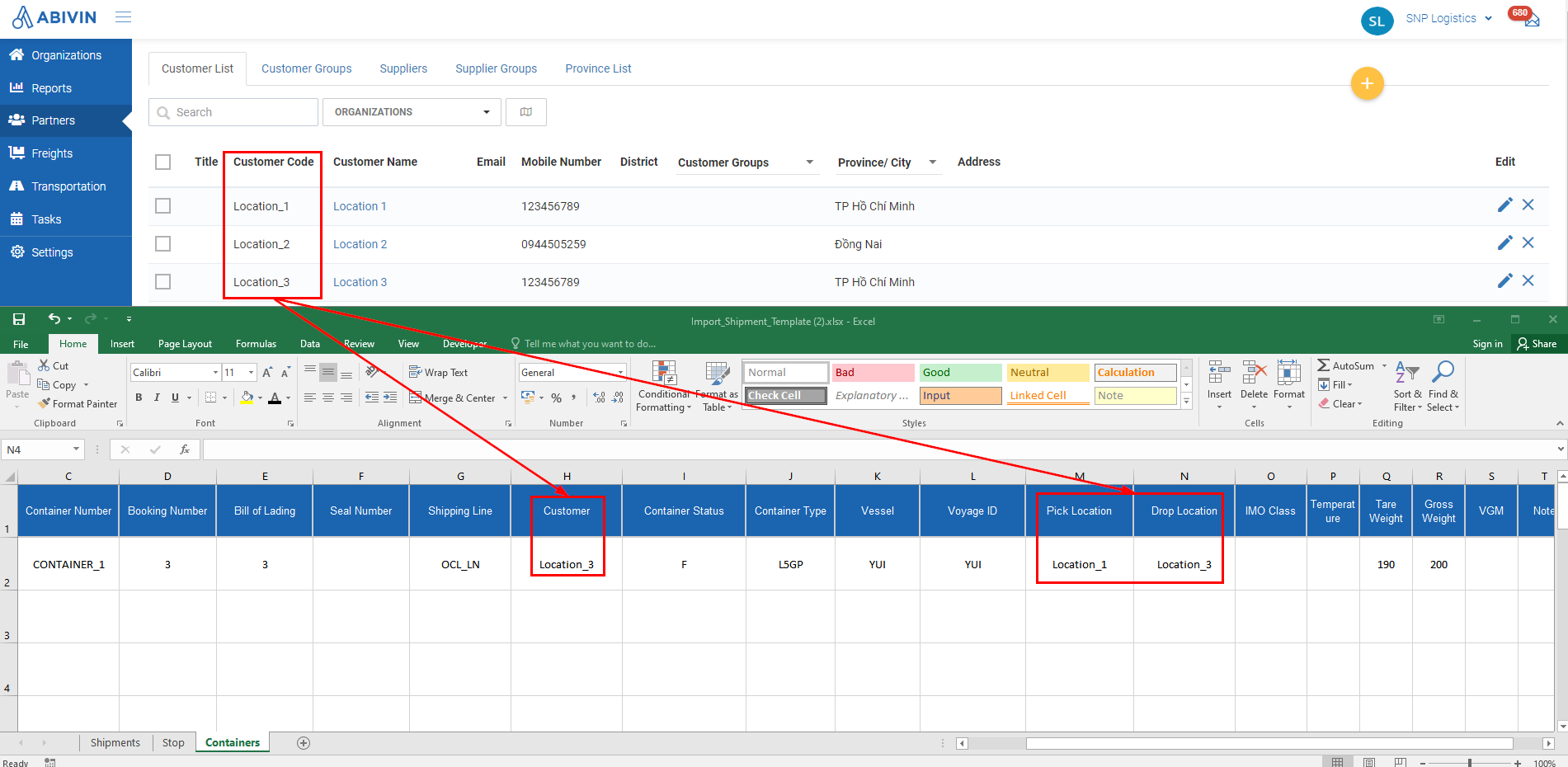
2.29. Container Status
- If the container has goods inside, input the following value into this cell: F
- If the container is an empty container, doesn't have goods inside, input the following value into this cell: E
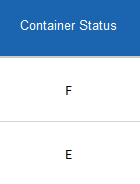
2.30. Container Type
- Copy the suitable container type code on Web app, then paste into this cell
- The container type code can be found under Container Type Code column in Freights > Container Types tab
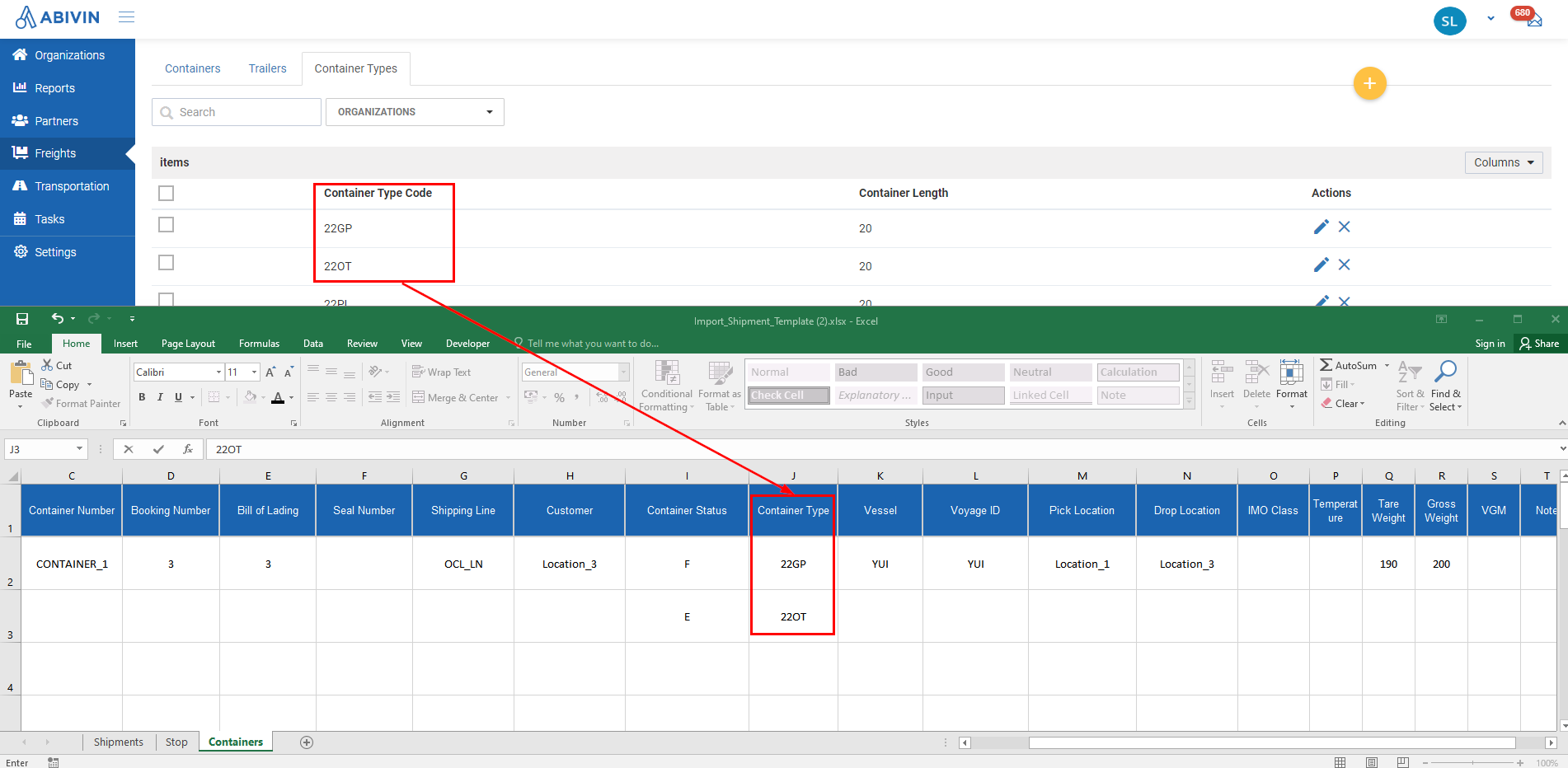
2.31. Vessel
- Input the code of the shipping vessel into this cell
- For example: EMPT; ATE; LGB etc.
2.32. Voyage ID
- Input the code of the voyage into this cell
2.33. IMO Class
- Input the following value into this cell if the container contains dangerous goods: FXIX
- Input the following value into this cell if the container contains oversize goods: FXXO
- If the container neither contains neither dangerous nor oversize goods, leave this cell blank

2.34. Temperature
- Input the corresponding temperature of the container (In degree Celsius)
- For example: 2; 4; -20 etc.
2.35. Tare Weight; Gross Weight; VGM
- Input the corresponding weights (In kilogram) into these cells
- For example: 2500; 3000; 33000 etc.
2.36. Note
- Format: Free-form
Rule about creating Dummy shipmentFor a barge, the previous assigned Dummy shipment has to be completed before the next assigned Dummy shipment can be created
Edit shipments
- To edit a Shipment, click on Edit icon of that Shipment. You might need to use the horizontal scrollbar to scroll to the end of the Shipment list to see this icon

Delete shipments
- To delete a Shipment, click on Delete icon of that Shipment. You might need to use the horizontal scrollbar to scroll to the end of the Shipment list to see this icon

Updated about 1 month ago
